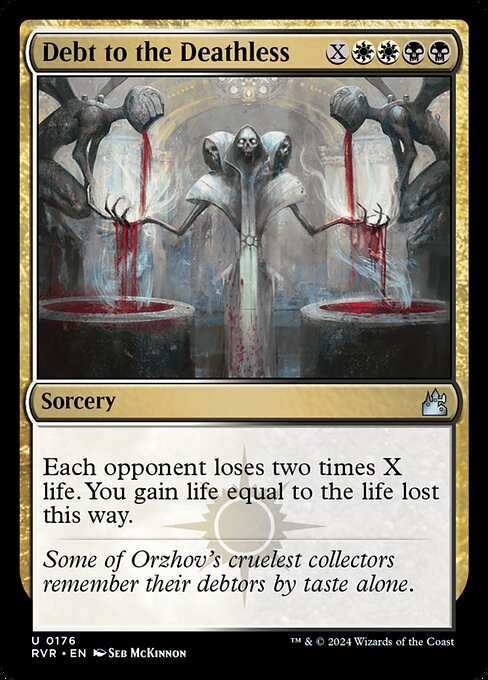
Image courtesy of Scryfall.com
Rarity and Mana Cost: A Curious Co-Dependence
In the sprawling mosaic of Ravnica Remastered, Debt to the Deathless stands out not because it’s the flashiest spell, but because it makes you think about value in two dimensions: rarity and mana cost. The card is an uncommon from the Orzhov-inflected set—White and Black mana in concert—and its mana cost is an unusual chimera: {X}{W}{W}{B}{B}. That single line of numerals tells you there’s more to the spell than a typical 5-mana finisher. 🧙♂️
First, the obvious: X is a variable mana component. In MTG, X spells create a sliding scale of power, and the rarity of the card often lags behind the potential that the mana cost suggests. Debt to the Deathless carries a converted mana cost of 4 as printed (the CMC listed as 4.0) but the X in its cost means the actual mana you invest can be anything from the base 4 up to whatever you can reasonably pay in a given game. The result? The card feels like a flexible tool, not a one-shot finisher, and that ambiguity is a hallmark of cards that slip into uncommon or rare depending on how you read their power curve. 🔎
We should also look at the color identity and the design space it occupies. With two white and two black mana in the cost, Debt to the Deathless sits squarely in Orzhov’s wheelhouse: life drain and life gain as a balancing act. The spread of mana requires black’s drain and white’s resilience—an elegant reminder that in multi-color design, rarity sometimes rides on the shoulders of hybrid identity rather than raw damage. The card’s rarity is coded in the print as uncommon, yet its per-game impact can swing dramatically with X. That juxtaposition is a telling sign of how Wizards of the Coast calibrates rarity for cards with variable costs. 🧙♀️🔥
How the effect scales with X
The effect is brutally simple on the surface: Each opponent loses two times X life, and you gain life equal to the life lost this way. In numbers, if you’re in a 3-player table and you set X to 2, you push 4 life from each opponent, or 12 life total, while you net 12 life. In a four-player commander game, throw in even higher X, and the math becomes a life-fest with a side of politics—your rivals suddenly reconsider how far they’re willing to push the table’s balance. This is the sort of spell that rewards careful counting and a read of the table state. It’s also one of those cards that can change the conversation at the table, from “we’re racing to 20” to “who can survive the swing and rebuild.” 🎲
And yes, the lifegain is real. You gain life equal to the life lost, which, in large X scenarios, can give you a surprisingly sticky buffer in long games. The lifegain also provides a natural counterplay against trouble like griefing tax effects or graveyard hate—Orzhov loves that push-pull dynamic, where you’re draining while you’re sustaining. The flavor text—Some of Orzhov's cruelest collectors remember their debtors by taste alone—casts a grimly elegant mood on the card, tying the mechanical heft to the guild’s reputation for debt and ritual.
Some of Orzhov's cruelest collectors remember their debtors by taste alone.🧁
Design, rarity, and the collector’s lens
From a design perspective, Debt to the Deathless demonstrates how rarity can ride a functionally powerful effect behind a scalable cost. The card’s existence in Ravnica Remastered—set in the Masters series known for reprinting popular modern era cards—aligns with a strategy: give players a familiar tool that’s reimagined in a new frame and with a tinge of mystery. The high-contrast B/W color pairing in the art and flavor is a masterclass in MTG mood: a chiaroscuro vibe that you can practically hear in Seb McKinnon’s pencil strokes. No wonder the card holds a place in many EDH and midrange theses about life swing and political combat. The rarity label doesn’t always reflect the maximum possible power of X; it reflects how widely Wizards expects players to draft or draw a given spell under typical conditions. And Debt to the Deathless somehow threads that needle, offering a fair but explosive ramp-up path that remains accessible in casual and semi-competitive play. 🧩
If you’re chasing value, the card is also a window into modern reprint economics. The USD value sits in a modest range for nonfoil and a bit higher for foil, and its EDHREC footprint suggests it’s more of a thematic pick than a universal staple. The card’s rarity helps keep it approachable for players who want a powerful spell without the bankroll risk of a mythic, while still offering a distinctive silhouette in a deck’s strategy. The art, the guild flavor, and the unique X-scale cost combine to make this card a memorable piece in any vault of MTG treasures and a reminder that rarity can be a design narrative, not just a label. 💎
For players who enjoy the “benign tyranny” vibe of Orzhov—where debt is a weapon as much as a policy—the card offers a satisfying blend of math and theme. If you’re looking to translate curiosity into a real plan, Debt to the Deathless is your ally: a spell that doesn’t require you to break the bank, but rewards careful play and table awareness. And the best part? The more you lean into the X mechanic, the more you’ll realize that rarity sometimes glances off the power curve, then nods with a knowing smile. 🧙♂️🔥
Neon Gaming Mouse Pad Rectangular 1/16 in Thick Rubber BaseMore from our network
- https://crypto-acolytes.xyz/blog/post/sega-vs-nintendo-the-console-wars-that-shaped-gaming/
- https://crypto-acolytes.xyz/blog/post/hot-32520-k-star-illuminates-galactic-plane-temperature-distributions/
- https://blog.digital-vault.xyz/blog/post/structuring-your-first-web-app-a-practical-roadmap/
- https://blog.digital-vault.xyz/blog/post/slowkings-best-type-matchups-for-competitive-battles/
- https://crypto-acolytes.xyz/blog/post/understanding-star-motions-via-proper-motion-vectors-of-a-distant-hot-giant/